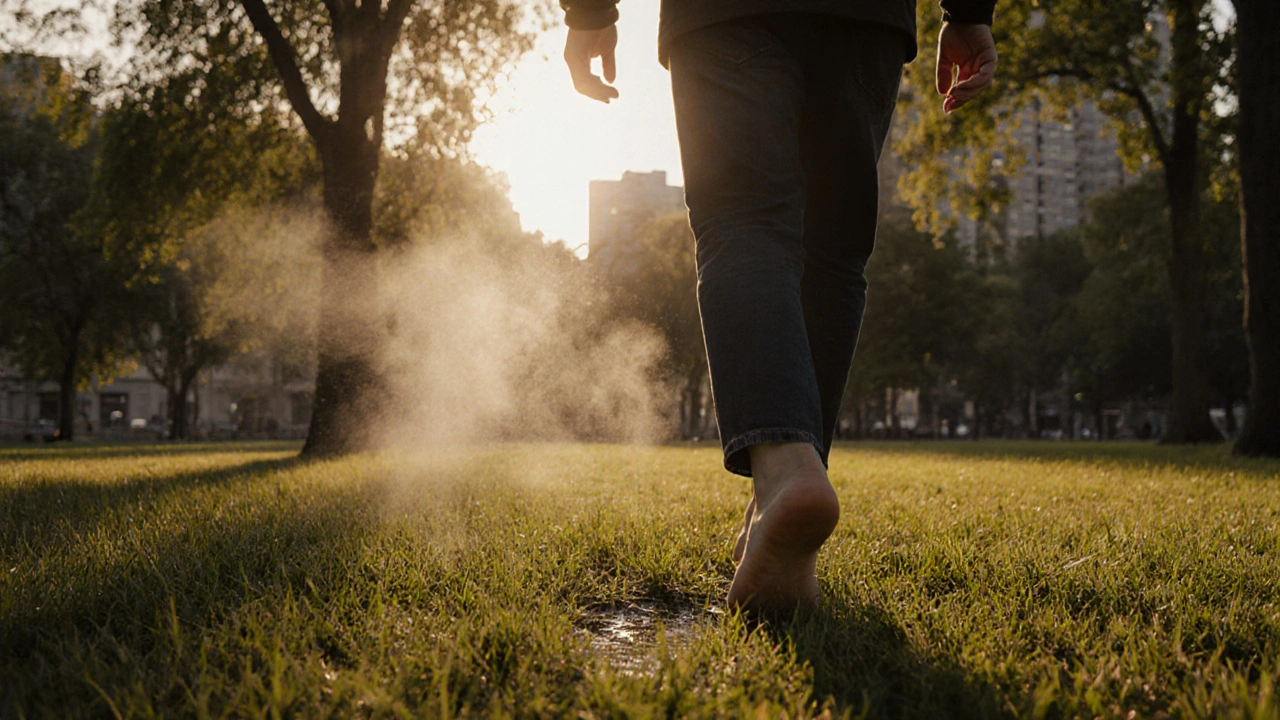Mindful Movement Tracker
Your Daily Mindful Movement Goal
Mindful Movement Ideas
Most people think exercise is about pushing harder, going faster, or burning more calories. But what if the real benefit isn’t in how much you do, but how fully you’re present while doing it? That’s the heart of mindful exercise.
What mindful exercise actually means
Mindful exercise is movement done with full attention-no distractions, no autopilot. It’s not about hitting a target heart rate or logging miles. It’s about noticing your breath, feeling your muscles work, sensing your balance, and tuning into the rhythm of your body as it moves.
Think of it like this: when you walk while scrolling through your phone, you’re just walking. When you walk while feeling each foot hit the ground, noticing the air on your skin, and matching your breath to your steps-you’re doing mindful exercise. The activity doesn’t change. Your awareness does.
Research from the University of California, San Francisco found that people who practiced mindful movement reported lower stress levels and improved body awareness after just eight weeks-even without changing their workout intensity. The difference wasn’t in the exercise. It was in the attention.
How it’s different from regular exercise
Regular exercise often focuses on outcomes: weight loss, muscle gain, endurance. Mindful exercise focuses on the experience itself. You’re not trying to get somewhere faster. You’re trying to be fully there.
Here’s how they compare:
| Aspect | Mindful Exercise | Traditional Exercise |
|---|---|---|
| Goal | Presence, awareness, connection | Performance, results, achievement |
| Focus | Body sensations, breath, environment | Reps, sets, time, calories |
| Distractions | Avoided (no music, no screens) | Common (podcasts, TV, playlists) |
| Intensity | Low to moderate | Often high |
| Outcome | Reduced stress, better body awareness | Strength, endurance, weight loss |
Mindful exercise doesn’t replace traditional workouts. It complements them. You can still run a 5K or lift weights. But if you bring awareness to those movements, you get more out of them-physically and mentally.
Examples of mindful exercise
You don’t need special equipment or a studio to practice mindful movement. Here are five simple ways to start:
- Mindful walking - Walk slowly. Feel your heel touch the ground, then the ball of your foot, then your toes. Notice how your arms swing. Listen to your breath. If your mind wanders to your to-do list, gently bring it back to your feet.
- Mindful stretching - Instead of rushing through your cool-down, hold each stretch for 30 seconds. Breathe into the tight spots. Notice how the sensation changes as you stay still.
- Mindful yoga - Yoga is naturally mindful, but many people rush through poses. Try holding each pose for five slow breaths. Focus on the alignment of your body, not how it looks.
- Mindful gardening - Feel the soil between your fingers. Notice the weight of the trowel. Pay attention to the smell of damp earth and the sound of rustling leaves. This counts as movement with awareness.
- Mindful swimming - Focus on the rhythm of your strokes and the way water flows around your body. Count your breaths between laps. Let the water be your anchor.
These aren’t exercises you do to get fit. They’re ways to reconnect with your body after hours of sitting, staring at screens, or rushing through life.

Why it works for your brain and body
Mindful exercise isn’t just a feel-good trend. It’s backed by science.
A 2023 study in the Journal of Clinical Psychology showed that people who practiced mindful movement had a 27% greater reduction in cortisol (the stress hormone) compared to those who did the same workouts without mindfulness. Their anxiety levels dropped. Their sleep improved. Even their pain tolerance increased.
Why? Because when you move with awareness, you activate the parasympathetic nervous system-the part of your body that says, “We’re safe now.” That’s the opposite of the fight-or-flight state most of us live in.
Also, mindful movement helps rebuild the connection between your brain and your body. Many people feel disconnected from their bodies after injury, illness, or long periods of sedentary living. Mindful exercise retrains that link. You start to notice when your shoulders are tight, when your jaw is clenched, when your breath is shallow. And because you notice, you can change it.
How to start (even if you’re busy)
You don’t need 30 minutes. You don’t need a mat. You don’t need to be flexible or fit.
Start with one minute.
Next time you walk from your car to your front door, pause. Take one slow breath. Then, as you step, notice: How does your foot feel? Is your weight shifting? Is your breath matching your steps? That’s it.
Or, while brushing your teeth, feel the bristles against your gums. Notice the temperature of the water. Listen to the sound of the brush. That’s mindful movement too.
Here’s a simple rule: Pick one daily movement and do it slowly, on purpose, once a day. It could be opening a door, climbing stairs, or pouring a glass of water. Do it like you’ve never done it before.
After a week, you’ll start to notice small shifts. You’ll feel calmer. You’ll catch yourself tensing up less. You’ll start to enjoy movement again-not because it’s hard, but because it’s alive.
Common mistakes and how to avoid them
Mindful exercise sounds simple. But it’s easy to get it wrong.
- Mistake: Thinking you have to clear your mind completely. Fix: Your mind will wander. That’s normal. The practice isn’t stopping thoughts-it’s noticing when you’ve drifted and gently returning.
- Mistake: Waiting for the “right” time. Fix: There’s no perfect moment. Do it while waiting for your coffee to brew. Do it while walking to the mailbox.
- Mistake: Judging yourself for not being “good” at it. Fix: There’s no skill level. You’re not trying to be zen. You’re just paying attention.
- Mistake: Turning it into another goal. Fix: Don’t track minutes or try to do it every day. Just do it when you remember. Consistency comes from curiosity, not pressure.
The goal isn’t perfection. It’s presence.

When mindful exercise helps most
This isn’t just for people who meditate or do yoga. It’s for anyone who:
- Feels burnt out from constant doing
- Has chronic pain and wants to reduce tension
- Struggles with anxiety or racing thoughts
- Feels disconnected from their body
- Is recovering from injury and needs gentle reconnection
- Just wants to feel more alive during the day
Mindful exercise doesn’t fix everything. But it gives you a tool to pause, breathe, and come back to yourself-no matter how chaotic your day is.
What to do next
Start small. Pick one movement you do every day. Walk, stretch, climb stairs, wash dishes. Do it slowly. Pay attention. No goals. No judgment.
After three days, ask yourself: Did I notice anything new? Did I feel calmer for even a few seconds? That’s the point.
Mindful exercise isn’t about becoming a better athlete. It’s about becoming more aware of the body you already have. And that’s something you can start right now-with your next step, your next breath, your next movement.
Is mindful exercise the same as meditation?
No. Meditation is usually done sitting still, focusing on breath or a mantra. Mindful exercise is movement with awareness. They’re cousins, not twins. You can do both, but you don’t need to meditate to practice mindful movement.
Can I do mindful exercise while listening to music?
It’s possible, but it defeats the purpose. Music pulls your attention outward. Mindful exercise asks you to turn inward. If you want to enjoy music, do it during regular workouts. Save mindful movement for quiet, uninterrupted time.
Do I need to be flexible or fit to try mindful exercise?
No. Mindful exercise works for every body. Whether you’re sitting in a chair, using a walker, or running a marathon, you can pay attention to how your body moves. It’s not about ability-it’s about awareness.
How long until I feel the benefits?
Some people feel calmer after just one session. Others notice changes after a week of daily practice. The key is consistency, not duration. Even one minute a day builds awareness over time.
Can children or older adults practice mindful exercise?
Absolutely. Children can practice mindful walking while waiting in line. Older adults can do seated mindful breathing while watching TV. It’s adaptable to any age or ability. The goal is connection, not performance.
Final thought
Mindful exercise isn’t about doing more. It’s about feeling more. In a world that rewards speed and output, choosing to move slowly and with attention is a quiet act of rebellion. And it’s one of the most powerful things you can do for your body, your mind, and your peace.
